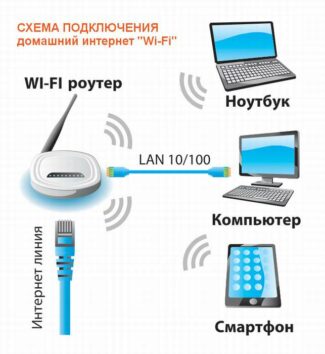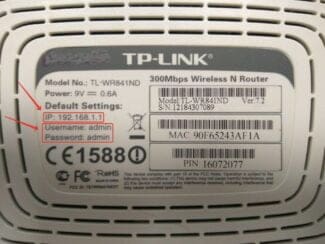Wi-Fi uses radio frequencies to transmit data. It uses the same principle of working with electromagnetic waves, including radio.

What is Wi-Fi and where did it come from
According to We Are Social and Hootsuite, there are 4.66 billion active internet users in the world at the beginning of 2021. There is often an equal sign between the term Wi-Fi and the Internet. But Wi-Fi is a wireless technology that makes it possible to go online.
You can be 50-100 meters away from a router and access the network simultaneously from multiple devices, which gives a distinct advantage over wired Internet. But Wi-Fi in its original form had a very different purpose.
There are several versions of the origin of the word "Wi-Fi":
- An acronym for "Wireless Fidelity" – wireless fidelity.
- A play on words with a hint of Hi-Fi from "High Fidelity," used in the context of sound.
- Short for Wireless Fidelity Alliance, the name of the manufacturer's company.
- There is no need to run a cable through the apartment.
- Access is possible from devices that do not have a LAN-port: phones, tablets, some laptops.
- Mobility: you can enter the network being away from the place of distribution.
- It is easier to connect multiple devices at the same time.
- When using a large number of connections at the same time Internet speed is lost.
- Wi-Fi can affect Bluetooth, microwave ovens when using the same frequency.
- If the router is of an older generation, it is not possible to get the maximum speed declared by the provider.
- Obstacles between the router and the user can interfere with signal transmission.
History of the invention
Progenitor of Wi-Fi was Hedy Lamarr – an American actress and inventor. During World War II it created technology that made the torpedo impossible to track or jam. For this purpose she used technology with pseudo-random frequency change (transmission channel). The musician George Antheil helped her to realize her idea. They developed the "jumping waves" together.
Before that, data could only be sent on one frequency, which could lead to interception of the torpedo control. This system was declassified in 1980. This made the knowledge that allowed Wi-Fi to be invented public.
The more familiar format of Wi-Fi was given by John O'Sullivan, a scientist and radio astronomer from Australia. During the experiments on the study of the black hole, the need to transfer data wirelessly arose. That's when Hedy Lamarr's developments were remembered and a semblance of modern Wi-Fi was created. Data transfer speed of the first invention did not exceed 2 Mbit/s.
Wi-Fi Internet connectivity now takes place over IEEE 802.11 radio links. IEEE is an acronym for IInstitute of Electrical and Electronics Engineers Institute of Electrical and Electronics Engineers. This association was founded in New York City in 1963 and has been actively developing industry standards which they still adhere to today.
Improvements in Wi-Fi connectivity are continually being made. As of May 2021, there are already six generations of Wi-Fi.
History
A 1985 ruling by the U.S. Federal Communications Commission released a portion of the ISM bands for unlicensed use for communications purposes. These bands are 2.4 GHz bands that are used by equipment such as microwave ovens, and they are susceptible to interference.
The prototype WLAN testbed was developed in 1992 by researchers from the CSIRO (Commonwealth Scientific and Industrial Research Organisation) Radio Physics Division in Australia. [3]
In 1991, in the Netherlands, NCR Corporation, together with AT&T Corporation, invented a precursor to the 802.11 standard for use in cash register systems. It was called WaveLAN. NCR manager Vic Hayes, who had led the 802.11 IEEA for 10 years, along with Bell Labs engineer Bruce Tuch, approached the Institute of Electrical and Electronics Engineers (IEEE). After that, they were both inducted into the NOW Wi-Fi Hall of Fame.
- In 1999, not only Wi-Fi, but the two protocols 802.11b and 802.11a are created. [4]
- In 2000, the first 802.11b devices went on sale.
- In 2002 – WiFi Alliance membership was increased to 100 member companies.
- In 2003 the 802.11g standard was released, combining the advantages of the previous two versions.
- 2005 saw the release of the best security protocol, WPA2.
- Beginning in 2005, wireless technology is already being used on some game consoles and digital cameras.
- A year later the testing of 802.11n would begin;
- 2009 – the release of devices with the 802.11n version, which can transmit data in two bands (2.4 and 5 GHz). [5]
- The active use of wireless communication in devices began.
- In 2014, the 802.11ac standard was launched.
- 2016 – versions of 802.11ah, 802.11ai appear [6] .
- In 2018, 802.11aj, 802.11aq, 802.11ay protocols are released.
- 2020 – creation of 802.11ax version.
Terminology
Illustration of a Wi-Fi network in infrastructure mode. A device sends information wirelessly to a printer, both connected to the LAN.
WDS
WDS (Wireless Distribution System) – is a technology that allows access points to work simultaneously with wireless clients and other user access points in wireless bridge mode. WEP (Wired Equivalent Privacy) is the oldest wireless traffic protection standard based on the RC4 (shared secret key) encryption method. There are variants with key length of 64, 128 or 256 bits. Using WEP to protect networks is not a reliable way of security. The problem is the implementation of the initialization vector selection as a pseudo-random sequence for data encryption. [7]
A router in a WDS network is a base, remote, or relay-relay station. The devices are usually connected by wire. Typically, remote routers are needed to connect clients over a WiFi network and relay stations are needed to communicate between two other stations. Its task is to relay and amplify the signal.
WLAN
WLAN (Wireless Local Area Network) is a wireless local area network, i.e. a computer network that covers a small area. WLAN is the term for home wireless networks based on an access point or wireless router.
WPA
WPA (Wi-Fi Protected Access) – is one of the security protocols, used for protection in wireless networks. A new protocol that was designed to replace the outdated WEP protocol was created. This protocol is based on TKIP , which effectively fights the problem of reusing the encryption keys.
Wireless Bridge
Wireless Bridge – A network device used for wireless communication between local area networks.
An object that has no life of its own
The actress married one of her admirers, the Viennese industrialist Fritz Mandl. However, the marriage proved to be an ordeal: her husband was morbidly jealous and wanted to control Hedy in everything. Fritz even tried to buy out all the existing copies of 'Ecstasy' so that no one could look at his wife.
Swedish poster to 'Ecstasy' (1933), a film highly controversial in its day for nude scenes involving Hedy Lamarr. pic.twitter.com/Z58R1HcIk7
– Wrong Reel (@WrongReel) October 25, 2015
"I realized very soon that I could never be an actress as long as I was his wife. He was the absolute monarch in our marriage," Hedy recalled. – And I was like a doll. Like a thing, some object of art, which should be guarded – and kept under lock and key – which has no mind, no life of its own.
In 1937, she took her jewelry, disguised herself as a maid, and fled Berlin for London, where she took the stage name Lamarr. Hedy chose it for a reason: Lamarr is a tribute to silent film actress Barbara La Marre and at the same time a reference to French la mer, which means "the sea", because the ocean separated Hedy from her native Austria.
In the UK, the actress met Metro Goldwyn Mayer boss Louis B. Mayer and through this acquaintance actually got a ticket to Hollywood. She moved to the United States and began working alongside the stars of the time. Lamarr's partners were Spencer Tracy, Clark Gable, James Stewart and Judy Garland.
Louis B. Mayer called Hedy "the most beautiful woman in the world." Lamarr was so popular that, according to one version, Walt Disney decided to give her features of Snow White, the heroine of the cartoon of the same name that was released in 1937. There is an opinion that Hedy also became the prototype of a famous American comic book character – Wonder Woman.
Condemned to be the personification of beauty
Lamarr herself was irritated and frustrated that she was admired only for her looks and ignored her intelligence and passion for science. Later, in a 1951 interview, Hedy said: "Everywhere I see that men pay homage to my beauty and show no interest in me. To me, beauty is a curse."
In Hollywood, Lamarr was not allowed to realize her full acting potential. Because of the spectacular appearance of her invited only the role of sensual femme fatale beauties and objectified. Viviane Perret noted: "Hollywood condemned her to be the personification of beauty and did not give her the artistic satisfaction she expected. Because of the accent and the imposed label of femme fatale, she was never able to truly express herself.
Apart from movies, however, Hedi had another way of expressing herself: science. At home, she set up a special workspace to engage in invention. Lamarr's acting trailer had a small set of essential tools with which she could work on new projects between takes.
In the 1940s, Lamarr had a relationship with Howard Hughes, a businessman and pilot who owned an airplane factory. One day he took Hedy to the factory and confided that he dreamed of developing a new model airplane capable of greater speed. It might interest the U.S. Armed Forces. Hedy bought a book on animal anatomy, pored over it, and designed a new airplane wing, combining the shape of fish fins and a bird's wing. When Lamarr showed her drawings to Hughes, he was impressed, saying: "You're a genius."
Working on her projects only when she wasn't filming, Hedy invented a mustard dispenser, a fluorescent dog collar and fizzy plates that, when dissolved in water, gave her a sweet taste reminiscent of Coca-Cola.
Read More:





